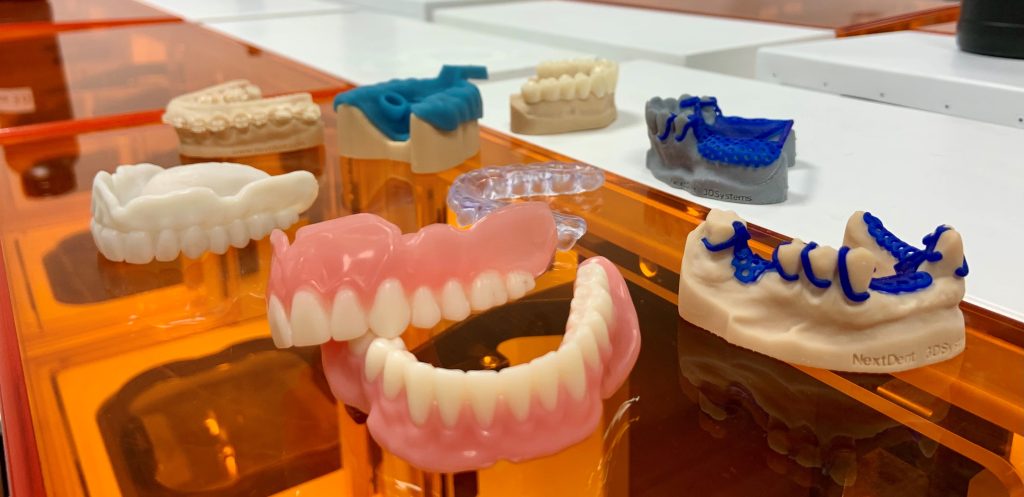June 2024 saw notable 3D printing developments across multiple sectors, including defense, dentistry, construction, and software.
This month’s highlights included 3D Printing Industry’s attendance at RAPID + TCT 2024, North America’s largest 3D printing event, held at the Los Angeles Convention Center from June 25–27, 2024.
Other notable events included Micronics launching its Micron desktop SLS printer, followed by its acquisition by Formlabs. Battlefield manufacturing made headlines again, and Protolabs shared insights into the industry’s growth trajectory.
Read on for novel developments in June from 3D Systems, Massachusetts Institute of Technology, the UK Government, Protolabs, and more.
Micronics joins Formlabs after SLS 3D printer launch
The month started with Wisconsin-based startup Micronics introducing the Micron desktop Selective Laser Sintering (SLS) 3D printer designed for professionals and hobbyists at $2999 through its Kickstarter campaign.
Offering industrial-grade performance, this 3D printer produces complex, durable parts without support structures by fusing powdered plastic layers with a high-powered laser. Using Nylon for strength and chemical resistance, the printer features a spacious build chamber, enclosed powder system, advanced filtration, and offline MicroSlicer software for optimized usability.
Shortly after this news, resin 3D printer manufacturer Formlabs acquired the Wisconsin-based startup, following the success of the Micron desktop printer. It raised $1,357,939 through the Kickstarter campaign before being discontinued due to the deal.
Co-founders Henry Chan and Luke Boppart joined Formlabs’ R&D team to develop affordable and user-friendly SLS printers based on Micronics’ support-free printing technology. Kickstarter backers received full refunds, $1,000 in Formlabs credit, and an Open Materials License.
Finalized after a meeting at Open Sauce 2024, this deal strengthens Formlabs’ SLS printing expertise, complementing its Fuse 1 Series while accelerating efforts to make industrial-grade 3D printing more accessible.


Advanced battlefield manufacturing with SPEE3D’s 3D printing
June 2024 showcased continued developments in on-site defense applications, with SPEE3D’s cold spray 3D printing technology playing a prominent role. The Australian manufacturer participated in the U.S. Naval Sea Systems Command’s (NAVSEA) inaugural SALVEX exercise at Pearl Harbor demonstrating its metal 3D printing for rapid naval repairs.
Navy reservists and the Naval Postgraduate School tested SPEE3D’s XSPEE3D and SPEE3Dcell systems in a simulated naval scenario, producing critical metal parts on demand. Designed for defense, the mobile XSPEE3D unit prints components up to 1m x 0.7m using materials like aluminum, copper, and stainless steel, with SPEE3Dcell providing integrated tooling and heat treatment.
This exercise highlighted the potential to resolve supply chain challenges and improve operational readiness through rapid, portable manufacturing solutions.
Ahead of our inaugural online event Additive Manufacturing Advantage Aerospace, Space & Defense, 3D Printing Industry attended TCT 3Sixty 2024. At the show, Digby Gill, Head of Advanced Manufacturing Capability Coherence for the British Army, explored the impact of 3D printing on battlefield operations. Highlighting the challenges posed by supply chain delays and obsolescence, Gill explained how AM is transforming the Army’s ability to produce mission-critical parts on demand.
Recent deployments during NATO’s Exercise Steadfast Defender demonstrated the effectiveness of fabricating vehicle and equipment components directly in the field, significantly reducing dependence on traditional supply chains. A key advancement has been the development of a digital repository that standardizes designs for consistent production, ensuring reliability across applications.
Training programs focused on technical skills, including CAD and materials science, were identified as crucial to expanding these capabilities. Tools like SPEE3D’s portable XSPEE3D system and recently launched new Expeditionary Manufacturing Unit (EMU) received recognition for their role in supporting these efforts, offering robust and user-friendly solutions for harsh environments.
Gill concluded by emphasizing the strategic importance of 3D printing in maintaining operational readiness and addressing the evolving demands of modern warfare.
RAPID + TCT 2024: Key highlights from North America’s largest 3D printing event
During the final week of June, RAPID + TCT 2024 attracted over 9,000 attendees and more than 400 exhibitors at the Los Angeles Convention Center between June 25-27. Having returned to the West Coast after nearly a decade, the event was the largest in its history.
This show featured a daily keynote series, including the Executive Perspectives session, where industry leaders discussed the opportunities and challenges influencing the broader AM adoption in sectors like electronics, among others. These discussions set the tone for the event, complementing the variety of exhibits and presentations that followed.
On the exhibit floor, industry leaders introduced a range of new systems and solutions. 3D printer OEM 3D Systems showcased the EXT 800 Titan Pellet, combining high-speed extrusion capabilities with a design suitable for compact workspaces. The focus on automation and scalability continued with BigRep with the launch of VIIO 250 and ALTRA 280 systems, emphasizing their suitability for producing large-scale components efficiently.
Focusing on configurable solutions, Additive Industries presented the MetalFab 300 Flex, which features an expandable build area to address varying production requirements. For the healthcare sector, Stratasys unveiled its J5 Digital Anatomy 3D printer, which caters to the demand for precise and cost-effective anatomical models.
Material and post-processing technologies were another major focus. XJet introduced its 17-4PH stainless steel, designed for industrial use, while Lithoz demonstrated its Ceramic 3D Factory, which supports decentralized production setups. Adding to post-processing solutions, Addiblast introduced the MARS04, a system designed for efficient de-powdering of large metal components.
In the software space, nTop launched nTop 5, which integrates advanced features to simplify complex design processes with CEO Bradley Rothenberg, providing insights on advancing computational design for AM through its latest software. Meanwhile, Ai Build showcased Aibuild 2.0, an AI-powered, cloud-based 3D printing software designed to generate tool paths and simplify user interaction, enhancing efficiency in design workflows.
Beyond the technical exhibits, the Hollywood Showcase, created in partnership with Gentle Giant Studios and Direct Dimensions, offered a creative perspective on 3D printing. Attendees explored 3D printed assets used in renowned franchises like Avatar and Star Wars, illustrating the technology’s impact on the entertainment industry.
Alongside 168 technical presentations on AM applications and sessions in the SME Zone Theater and Tech Hub, key awards highlighted notable achievements. Andreas Vlahinos was honored for designing a patient-specific femoral implant, and Paul Gradl was recognized for advancing NASA missions.
Meanwhile, the Raffles Institution and the University of Waterloo earned awards in the Digital Manufacturing Challenge for high school and university projects. Start-ups also gained recognition, with Onulis winning for its WRAP Prime product and 3D Solar recognized for hybrid 3D printing in automotive supply chains. Fabrisonic and Vivid Creative Aquatics showcased their contributions by joining the AM Production Club.


The mini and the mighty 3D printers
3D printers with sizes on opposite sides of a scale hit the headlines this month. Researchers from the Massachusetts Institute of Technology (MIT) and The University of Texas (UT) at Austin unveiled a chip-based 3D printer that uses a millimeter-scale photonic chip to cure resin with visible light, creating intricate structures in minutes.
For this research, the team demonstrated fabricating a microscale MIT logo in just six minutes, showcasing its potential for compact, low-cost production. Designed to address the limitations of bulky traditional 3D printers, the technology holds promise for applications such as on-demand medical devices and engineering prototypes. Future plans include integrating holographic light, allowing entire objects to be fabricated in a single step, marking a significant leap in additive manufacturing capabilities.
On a larger scale, The Tekniker Technology Centre, part of the Basque Research and Technology Alliance (BRTA), showcased its 3-meter-tall TITAN 3D printer at International Machine Tool Biennial Exhibition (BIEMH) 2024. Measuring 6100 mm x 3100 mm x 3420 mm, TITAN uses Direct Energy Deposition (DED) technology to produce complex metallic structures, including a rocket engine nozzle capable of withstanding Mars-like conditions.
Developed with a controlled atmosphere enclosure, the system caters to industries such as aerospace and shipbuilding that demand components capable of enduring extreme environments. Tekniker’s exhibit will also feature a collaborative robotic cell, equipped with SmartPicking software for precise part handling and safety tools for human-robot interactions.
3D Systems secures its largest dental aligners contract
June 2024 also saw 3D Systems announce a five-year contract valued at nearly $250 million to produce clear dental aligners. Plans are underway to launch direct printing technology for aligners by late 2025, alongside expanding its dental solutions portfolio to include alignment, protection, repair, and tooth replacement.
According to the company, NextDent technologies are being utilized to address growing needs in areas such as night guards and crowns, with the digital dental segment projected to reach $12.2 billion by 2028. Moreover, additional developments include multi-material dentures and partnerships with dental labs including the likes of Align Technology, aligning with the anticipated growth of the global dental 3D printing market to $14.6 billion by 2032.


UK tightens export controls on advanced technologies
The UK Government introduced export controls on emerging technologies, including metal 3D printers, semiconductors, quantum computers, and cryogenic systems. These regulations came into effect on April 1, 2024, under The Export Control (Amendment) Regulations 2024 (ECO 2024).
Administered by the UK Export Control Joint Unit (ECJU), these restrictions target military goods and dual-use technologies, such as metal 3D printers that utilize lasers, electron beams, or electric arcs, as well as related software. Export licenses are now required for these technologies, along with semiconductor manufacturing tools, quantum computing equipment, cryogenic systems, and specific advanced materials.
Aligning with similar policies in the US and EU, the measures reflect a broader effort to safeguard advanced technologies for economic and national security. Strengthening domestic supply chains, particularly in 3D printing, is also a priority amid global uncertainties, underscoring the strategic importance of these new controls.
Protolabs highlights growth in 3D printing market
Significant developments shaping the future of additive manufacturing were highlighted by Protolabs’ 2024 3D Printing Trend Report, offering insights from over 700 engineering experts on the state and future of the global 3D printing industry.
This report highlights significant growth, with the market reaching $24.8 billion in 2024 and projected to hit $57.1 billion by 2028, driven by new micro-scale and large-format applications and the rise of production-scale 3D printing for end-use parts. It also reveals that 70% of businesses increased 3D printing activity in 2023, with the medical sector identified as having the highest potential impact.
A shift toward production-scale manufacturing is underway, with 76% of respondents reporting production runs exceeding 10 parts and growing interest in localized production to address supply chain disruptions.
Artificial intelligence and developments in materials, including multi-material and specialized properties like elasticity and conductivity, are expected to shape the sector further. Despite this progress, prototyping remains the primary use case, as 67% of respondents cited it as their main application. The report concludes that as education and awareness grow, 3D printing will increasingly transform the manufacturing industry.
3D Printing News Highlights from 2024: Innovations, Trends, and Analysis
What 3D printing trends do the industry leaders anticipate this year?
What does the Future of 3D printing hold for the next 10 years?
To stay up to date with the latest 3D printing news, don’t forget to subscribe to the 3D Printing Industry newsletter or follow us on Twitter, or like our page on Facebook.
While you’re here, why not subscribe to our Youtube channel? Featuring discussion, debriefs, video shorts, and webinar replays.
Featured image shows the entrance to RAPID + TCT 2024. Photo by 3D Printing Industry.


